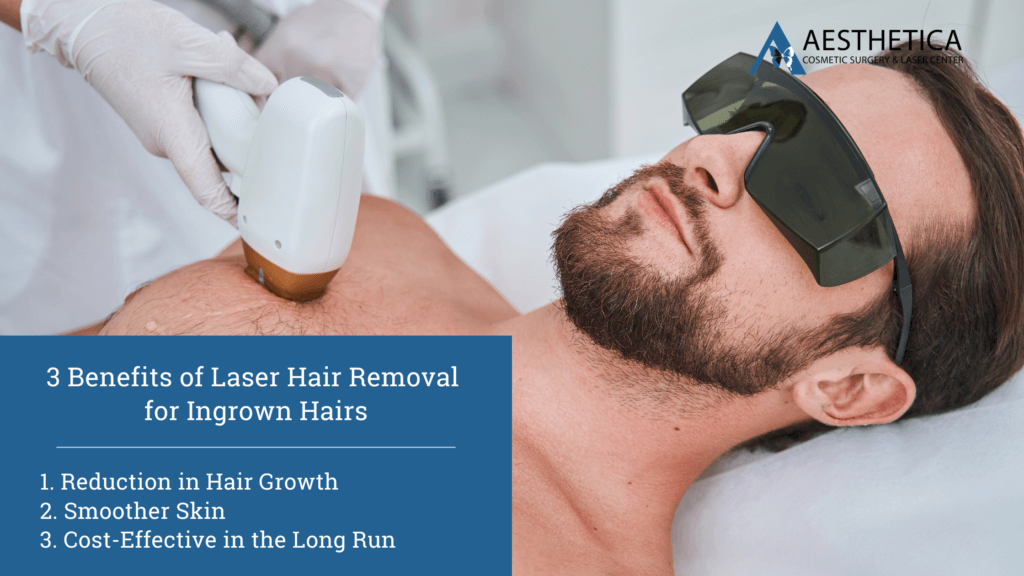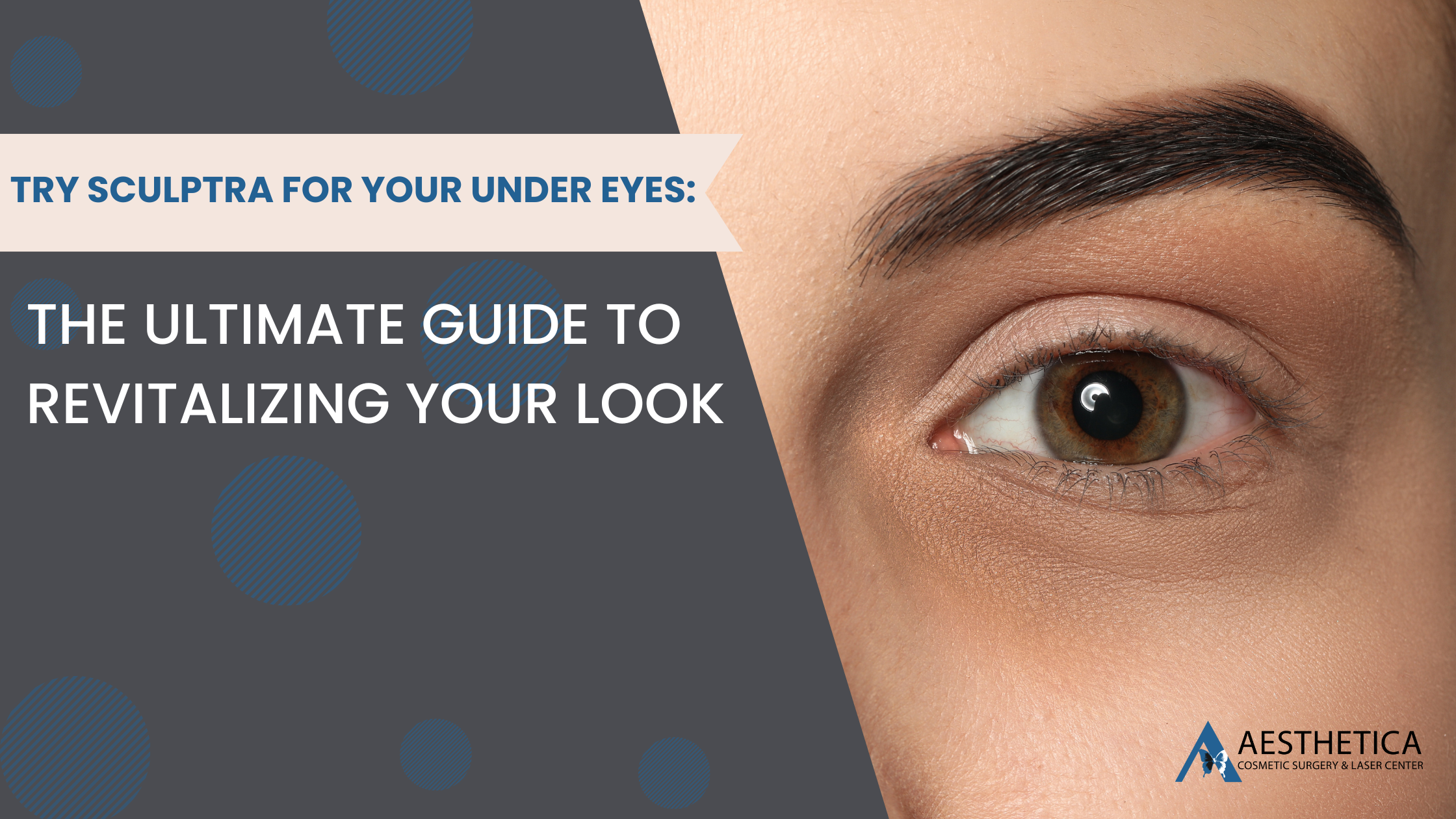Is Laser Hair Removal a Permanent Solution to Ingrown Hairs?8 min read

Aesthetica Editorial Team

With the advent of advanced cosmetic procedures, many have turned to laser hair removal as a solution to ingrown hairs.
But is it the ultimate answer to this age-old problem?
Understanding Ingrown Hairs
Ingrown hairs develop when cut or broken hairs curl back or penetrate sideways into the skin instead of growing outward. This misdirection often results from methods like shaving, waxing, or tweezing.
When the hair embeds itself into the skin, it causes red, itchy bumps that resemble pimples. Over time, these bumps become inflamed, leading to discomfort, pain, and even the possibility of infection if left untreated. Pus-filled blisters might also form around the ingrown hair, exacerbating the condition.
People with curly or coarse hair find themselves particularly susceptible to ingrown hairs. Their hair’s natural twist and curve make it easier for the tip to re-enter the skin after being cut.
Tight clothing also exacerbates the condition, pressing the hair back into the skin.
What is Laser Hair Removal?
Laser hair removal is a cosmetic procedure that employs a concentrated beam of light (laser) to remove unwanted hair. The intense laser heat damages the hair follicle, hindering its future hair growth capacity.
Laser hair removal uses concentrated light beams to target melanin in hair follicles. The melanin absorbs light energy, turning it into heat that damages the follicle. This damage slows down hair growth or even stops it completely.
Plastic surgeons may remove laser hair on almost any body part, including the face, legs, arms, underarms, and bikini line. While the process is not pain-free, many patients describe the sensation as a rubber band snapping against the skin.
Is Laser Hair Removal a Permanent Solution to Ingrown Hairs?

Many have hailed laser hair removal as a permanent solution to ingrown hairs. But, the term “permanent” can be slightly misleading. Here’s why:
- Hair Growth Cycles: Hair grows in different cycles—anagen (growth), catagen (transitional), telogen (resting), and exogen (hair fall). Laser treatments primarily target hairs in the anagen phase. Since not all hairs are in the same stage simultaneously, you would need multiple sessions for comprehensive treatment.
- Varying Results: Some patients see slower regrowth, while others experience a more prolonged hair-free period. Factors affecting the results include skin type, hair color, and the practitioner’s expertise.
- Maintenance Treatments: Maintenance treatment sessions tackle hairs that might’ve been dormant during the initial treatment sessions or become active again.
3 Benefits of Laser Hair Removal for Ingrown Hairs

- Reduction in Hair Growth: One of the apparent advantages of laser hair removal is the significant decrease in hair growth. While it doesn’t eliminate hair growth, the drastic reduction ensures a substantially lower chance of hairs turning ingrown. Fewer hairs mean fewer opportunities for them to embed themselves into the skin.
- Smoother Skin: Traditional hair removal methods often leave the skin rough, irritated, or inflamed. But with laser hair removal, patients may bid farewell to the endless cycle of shaving or waxing. Over time, the treated skin areas become smoother, softer, and free from the irritation commonly associated with regular hair removal practices.
- Cost-Effective in the Long Run: On the surface, laser hair removal is a hefty investment. However, the math makes sense when you compare it with the lifelong expenses of purchasing razors, wax strips, depilatory creams, and other hair removal products. After a few sessions, laser
3 Laser Hair Removal Precautions and Considerations

- Seek Professional Consultation: Consult a qualified dermatologist or a certified laser practitioner before embarking on your laser hair removal journey. These professionals deeply understand the procedure and offer advice specific to individual skin and hair types.
One such expert in the field is Dr. Philip Chang of Aesthetica, a board-certified plastic surgeon renowned for his long-established expertise. Together with his team of skilled professionals, they offer comprehensive consultations and treatments, ensuring patients receive the best care tailored to their unique needs. - Avoid Sun Exposure: Exposing your skin to the sun before and after laser treatment increases the risk of complications. The sun’s UV rays add to your skin sensitivity, raising the chances of burns or pigment changes during the procedure.
Always wear a high-SPF sunscreen and refrain from extended sun exposure during the weeks leading up to and following your treatment sessions. - Understand the Potential Side Effects: Most patients only experience mild symptoms like temporary redness, swelling, and changes in their skin’s pigmentation, either lightening or darkening.
8 Post-Treatment Care Tips for Laser Hair Removal

After laser hair removal, proper post-treatment care is paramount for optimal results and healing. Here’s a guide to help navigate the post-treatment phase:
- Moisturize Regularly: Use a gentle, fragrance-free moisturizer to soothe the skin and reduce any dryness or tightness. Regular moisturization also prevents the formation of scabs or crusts.
- Avoid Heat: Refrain from using hot water in the treated area for at least 48 hours. Hot showers, saunas, and steam rooms exacerbate skin sensitivity and irritation post-treatment.
- Wear Loose Clothing: Wear loose-fitting clothes to reduce the risk of irritation and prevent ingrown hairs.
- Limit Physical Activity: Limit vigorous physical activities that induce sweating for the first couple of days. Sweat increases irritation and discomfort on freshly treated skin.
- Sun Protection: Post-treatment skin is sensitive to sun exposure. Consistently apply a broad-spectrum sunscreen, even on cloudy days, to protect the skin from UV rays and prevent potential pigmentation changes.
- Exfoliate Gently: Gently exfoliate the treated area twice weekly to remove dead skin cells and reduce the chances of ingrown hairs. Use a mild exfoliant and avoid aggressive scrubbing.
- Avoid Tweezing or Waxing: Let the hair fall out naturally after laser hair removal. Avoid tweezing, waxing, or other hair removal methods on the treated area. If you notice any stray hairs, trimming them with scissors is acceptable.
- Consult Your Practitioner for Persistent Ingrown Hairs: If, after the treatment, you still notice persistent ingrown hairs, consult your practitioner. They will provide further advice or recommend products to address and prevent ingrown hairs.
5 Ways to Avoid Ingrown Hairs

Ingrown hairs are a nagging skin concern. Still, with suitable preventive measures, you can minimize the recurrence of ingrown hairs!
- Choose the Right Shaving Tools: Always use a sharp, clean razor. Dull blades tug at the hairs instead of cutting them cleanly, increasing the risk of hairs curling back into the skin.
- Prep Your Skin: Soften the hair and skin before shaving or waxing by soaking in warm water. Apply a lubricating shaving gel or cream to reduce friction and get a smoother shave.
- Shave in the Direction of Hair Growth: While it might not give the closest shave, it reduces the chances of hair re-entering the skin. Remember to rinse the blade between strokes.
- Exfoliate Regularly: Gently exfoliating the skin removes dead cells that could trap hairs. Use a mild exfoliating scrub or a soft brush to keep your skin smooth and free of ingrown hairs.
- Wear Breathable Clothing: Tight clothing presses hair back into the skin, especially after shaving or waxing. Opt for loose-fitting, breathable fabrics, especially around recently treated areas.
Take Control of Your Skin's Future Today!

Don’t let ingrown hairs and constant shaving dictate your skincare routine. Dive deeper into the world of laser hair removal with the guidance of industry experts like Dr. Philip Chang and his team at Aesthetica!
Meet us at 19500 Sandridge Way, Suite 350, Leesburg, VA 20176, or call us at (703) 574-4342 for a complimentary consultation with Board-Certified Plastic Surgeon Dr. Phillip Chang before moving forward with your procedure. If everything matches up, our team will help you navigate the entire process from beginning to end. Also, remember to check out our blog and social media for more information on cosmetic surgery trends!
References
- Cherney, Kristeen. “Laser Hair Removal Aftercare: Do’s, Don’ts, When to Seek Help.” Healthline, Healthline Media, 13 Sept. 2021, www.healthline.com/health/beauty-skincare/laser-hair-removal-aftercare. Accessed 19 Oct. 2023.
- “Ingrown Hair.” Mayo Clinic, Mayo Foundation for Medical Education and Research, 18 May 2022, www.mayoclinic.org/diseases-conditions/ingrown-hair/symptoms-causes/syc-20373893. Accessed 19 Oct. 2023.
- “Ingrown Hair: What It Looks like, Causes, Treatment & Prevention.” Cleveland Clinic, my.clevelandclinic.org/health/diseases/17722-ingrown-hair. Accessed 19 Oct. 2023.
- “Laser Hair Removal: 5 Reasons Why It Is Cost-Effective.” Cutis Laser Clinics Singapore, 24 June 2022, www.cutislaserclinics.com/blog/laser-hair-removal-5-reasons-why-it-is-cost-effective/. Accessed 19 Oct. 2023.
- “Laser Hair Removal: Faqs.” American Academy of Dermatology, www.aad.org/public/cosmetic/hair-removal/laser-hair-removal-faqs. Accessed 19 Oct. 2023.
- “The Importance of Your Hair Growth Cycle for Laser Hair Removal.” Infinity Laser Spa, Infinity Laser Spa, 6 Feb. 2020, infinitylaserspa.com/blogs/blog/hair-growth-cycle-laser-hair-removal. Accessed 19 Oct. 2023.
Let Us Help You!
Our office can provide you with helpful information, schedule a free consultation, and walk you through the many services and procedures we provide.
Contact Dr. Chang's Office:
More Articles For You

Try Sculptra for Your Under Eyes: The Ultimate Guide to Revitalizing Your Look
In aesthetic enhancements, Sculptra has emerged as a revolutionary treatment, especially for addressing concerns about

The Latest Techniques in Double Chin Removal in Leesburg, VA
In the charming town of Leesburg, VA, where looking good and feeling great are top

The Art of Refining the Side Profile of a Woman through Plastic Surgery
In the realm of cosmetic enhancements, the side profile of a woman holds a pivotal

Enhance Now, Pay Later: Plastic Surgery Payment Plans in Leesburg, VA
In the picturesque town of Leesburg, VA, pursuing beauty and self-improvement is a journey many
